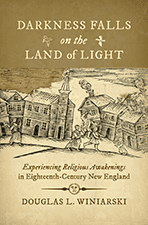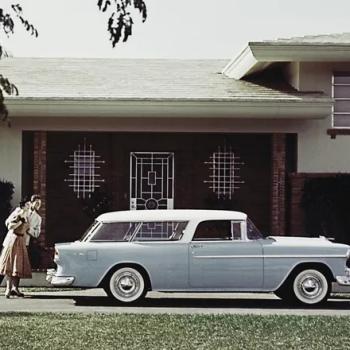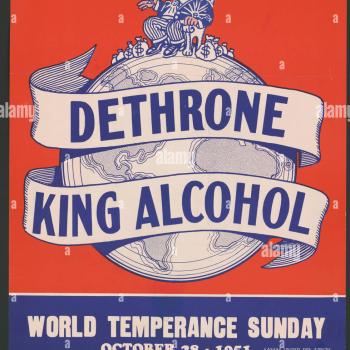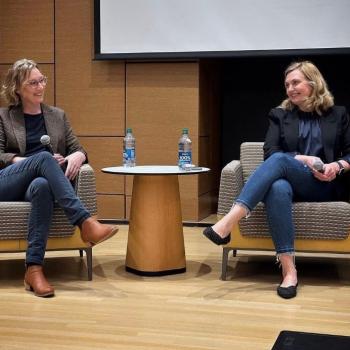Douglas Winiarski’s Darkness Falls on the Land of Light begins with the story of two couples in Sturbridge, Massachusetts. In the winter of 1748-1749, Hannah and John Corey withdrew from Sturbridge’s Congregational church, were baptized, and united themselves to a Separate congregation.
The couple had belonged to the Sturbridge Congregational church for around seven years, but by the fall of 1748, Hannah Corey believed that God was telling her to “come out from amongst them.” (Coincidentally, the passage was a favorite among English Brownists and separatists in the late 1500s and early 1600s, including the Leiden congregation that transplanted a part of itself to Plymouth Colony). When the couple left their church, Hannah Corey wrote a testimony. “I thought,” she explained, “I had rather ly down among the Graves then go into the meeting house.” It was now “a dark place” to her.
Their new congregation was very different. They experienced wonders. Congregants experienced physical manifestations of the Holy Spirit. They sang hymns loudly. Women spoke during meetings. Their pastor healed the sick and the lame. “I Se myself One in the Lord and one with them,” Corey concluded.
Others in Sturbridge saw things differently. At roughly the same time that the Coreys left their church, Moses and Ruth Holbrook joined it. Indeed, whereas the Coreys believed that a violent thunderstorm was a warning to leave the church, the Holbrooks interpreted it as a summons to join it. Ruth and Moses wrote brief spiritual autobiographies to qualify themselves for membership. Whereas Hannah Corey considered her old meetinghouse a “dark place,” the Holbrooks rejoiced that they had been “born in the land of lite” and “livead under the preaching of the gospel.” How does a historian make sense of these two couples? What label do we give to the Coreys, and what label is most appropriate for the Holbrooks?
 I’ve been looking forward to this book for a long time, ever since I read Winiarski’s article about visions in early 1740s New England. [“Souls Filled with Ravishing Transport: Heavenly Visions and the Radical Awakening in New England,” William and Mary Quarterly 61 (Jan. 2004): 3-46].
I’ve been looking forward to this book for a long time, ever since I read Winiarski’s article about visions in early 1740s New England. [“Souls Filled with Ravishing Transport: Heavenly Visions and the Radical Awakening in New England,” William and Mary Quarterly 61 (Jan. 2004): 3-46].
Darkness Falls on the Land of Light is a thick book, but essential reading for students of early American “evangelicalism.” Winiarski tells a story of “insurgent religious radicalism,” as “New Lights” or “Whitefieldians” formed new churches and fellowships.
I will attempt a review of the full book at some point, but I was immediately struck by Winiarski’s introductory comments about terminology.
I put “evangelicalism” in quote above because Winiarski offers some very useful cautions about the scholarly use of that term. As Winiarski notes, many scholars of “evangelicalism” rely on David Bebbington’s quadrilateral, which asserts that evangelicalism was characterized by conversionism, biblicism, activism, and crucicentrism.” Winiarski counters that this definition “masks far more than it illuminates the popular religious cultures of the eighteenth-century British Atlantic.”
There were new things under the sun in the 1730s and 1740s. Contemporaries referred to it as a “great Reviveal of Religion” or “great religious commotions.” Later generations would call it a “great awakening.”
What resulted from it? What is clear is that those who embraced and experienced these awakenings did not — at least in the overwhelming number of cases — refer to themselves as “evangelicals.” Detractors referred to them as “New Lights” because they believed in forms of “continued revelation,” “the bodily presence of the indwelling Holy Spirit,” and “dramatic visionary phenomena.” Chauncey meant “New Light” as a pejorative (New England ministers had long been cautious about claims of immediate revelation), but proponents eventually embraced the term.
Winiarski reintroduces the term “Whitefieldarians,” which some late eighteenth- and early nineteenth-century Americans did use. “In 1750,” he writes, “to be a Whitefieldarian was to be a religious radical.”
Winiarski’s conclusions about the awakenings and “evangelicalism” are roughly congruent with those of both Catherine Brekus and our former contributor Thomas Kidd. If we want to talk about “evangelicalism,” we need to recognize that the term is largely anachronistic and that it refers to — as Brekus writes — a “loose coalition of leaders, ideas, and practices.”
I appreciate Winiarski’s caution. It is not easy to avoid anachronistic labels. Pilgrims for the Plymouth separatists. Puritans for dissenting members of the Church of England in the late 1500s. Evangelicals for the “New Lights” and “Whitefieldarians” of the mid-eighteenth century. Our first recourse should be to the way that individuals and movements identified themselves and to the ways that their contemporaries identified them.
Evangelicalism in particular is such a nebulous and slippery term that it only works precisely for the “neo-evangelical” or “new evangelical” movement bent on reforming fundamentalism in the 1940s and 1950s (and perhaps for the decades following). In other contexts, it falsely suggests a cohesion and uniformity that has never existed among the “revivalist” wing of American Protestantism. It is a hard term to escape, however, as illustrated by Winiarski’s own use of the term in his introduction and more occasionally elsewhere.
What say ye? Shall Patheos rename this channel the “Whitefieldarian Channel?”
















